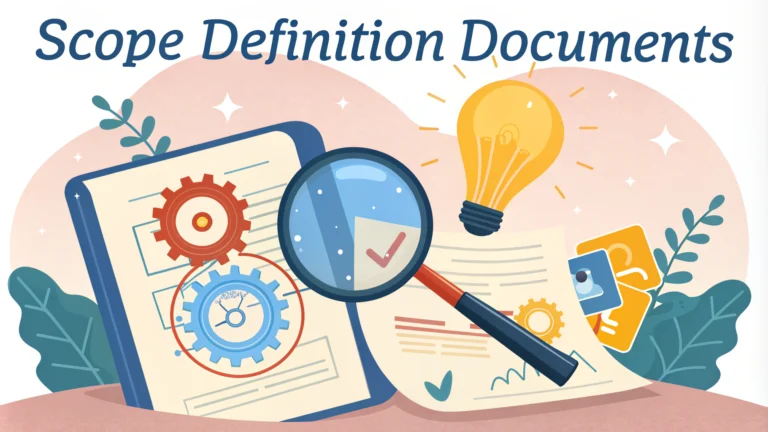A scope definition document outlines the specific boundaries, targets, and rules of engagement for a penetration testing project.
These documents protect both the testing team and the client by clearly stating what systems can be tested and which actions are permitted.
Creating detailed scope documentation helps prevent accidental damage to systems while ensuring all critical assets receive proper security assessment.
Key Components of Scope Definition
- Target systems and IP ranges
- Testing timeframes and schedules
- Excluded systems and networks
- Permitted testing methods
- Emergency contact information
- Reporting requirements
Target System Documentation
List all in-scope IP addresses, domains, and web applications with specific testing boundaries for each.
| Asset Type | Required Details |
|---|---|
| IP Ranges | CIDR notation, subnet masks |
| Domains | Full URLs, subdomains |
| Applications | Access points, authentication methods |
Testing Restrictions
- No Denial of Service (DoS) testing without explicit permission
- Social engineering limitations
- Password policy restrictions
- Data exfiltration boundaries
- Production system testing rules
Contact Information Requirements
Document primary and backup contacts for both the testing team and client organization.
- Emergency response team phone numbers
- System administrator contact details
- Project manager information
- Escalation procedures
Testing Schedule Details
Specify exact testing windows and any blackout periods where testing must stop.
- Start and end dates
- Permitted testing hours
- Maintenance windows
- Business-critical timeframes
Documentation Requirements
Define the expected format and content of testing reports and documentation.
- Evidence collection standards
- Screenshot requirements
- Vulnerability classification system
- Report delivery timeline
Legal Considerations
Include necessary legal disclaimers and testing authorizations.
- Non-disclosure agreements
- Testing authorization letters
- Liability limitations
- Data handling requirements
Next Steps for Implementation
Review the scope document with all stakeholders before starting any testing activities.
Keep the document updated throughout the testing process as new systems or restrictions are identified.
Store signed copies securely and distribute to all relevant team members.
Testing Methodology Documentation
Define specific testing approaches and tools that will be used during the assessment.
- Approved scanning tools
- Manual testing procedures
- Exploitation limitations
- Data collection methods
Risk Management Procedures
Outline processes for handling potential issues during testing activities.
- Incident response procedures
- System recovery protocols
- Testing suspension criteria
- Stakeholder notification requirements
Compliance Requirements
Document relevant regulatory and compliance considerations that impact testing.
- Industry-specific regulations
- Data protection requirements
- Compliance framework alignment
- Audit trail maintenance
Deliverables Specification
Required Documentation
- Executive summary reports
- Technical findings documentation
- Remediation recommendations
- Testing evidence artifacts
Presentation Requirements
- Stakeholder briefings
- Technical debriefings
- Remediation workshops
Ensuring Successful Scope Management
Regular scope reviews and updates maintain testing effectiveness while protecting critical systems.
- Establish clear communication channels
- Maintain detailed documentation trails
- Monitor scope compliance continuously
- Address scope changes promptly
- Review and update authorization as needed
FAQs
- What is a Scope Definition Document in penetration testing?
A Scope Definition Document is a formal agreement that outlines the specific systems, networks, applications, and boundaries that will be tested during a penetration test engagement. - What are the essential components of a penetration testing scope document?
The essential components include target systems and IP ranges, testing timeframes, excluded systems, testing methods allowed, emergency contacts, success criteria, and reporting requirements. - Why is it crucial to have well-defined scope boundaries?
Well-defined scope boundaries prevent unintended system disruptions, ensure legal compliance, protect sensitive assets, and provide clear guidelines for penetration testers to avoid testing unauthorized systems. - How should testing limitations be documented in the scope?
Testing limitations should specify prohibited testing techniques, blackout periods, system exclusions, and any restrictions on social engineering or denial of service testing. - What legal considerations should be included in the scope document?
Legal considerations should include testing authorization, data handling requirements, non-disclosure agreements, liability clauses, and compliance with relevant regulations like GDPR or HIPAA. - How are third-party assets handled in scope definition?
Third-party assets require explicit written permission from asset owners, clear documentation of testing boundaries, and may need separate agreements or notifications to vendors. - What escalation procedures should be defined in the scope document?
Escalation procedures should outline communication channels, emergency contacts, incident response processes, and steps to follow if critical vulnerabilities are discovered. - How should cloud environments be addressed in the scope definition?
Cloud environments require specific documentation of testing permissions from cloud service providers, identification of shared infrastructure limitations, and clear boundaries between in-scope and out-of-scope cloud resources. - What role do success criteria play in the scope document?
Success criteria define the objectives and deliverables of the penetration test, including reporting requirements, severity classifications, and metrics for measuring test effectiveness. - How often should scope definition documents be updated?
Scope definition documents should be reviewed and updated before each new penetration testing engagement, when significant infrastructure changes occur, or when compliance requirements change.







